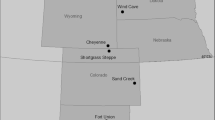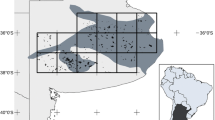Abstract
Precipitation quantity has been shown to influence grassland aboveground net primary productivity (ANPP) positively whereas experimental increases in of temporal variability in water availability commonly exhibit a negative relationship with ANPP. We evaluated long term ANPP datasets from the Konza Prairie Long Term Ecological Research (LTER) program (1984–1999) to determine if similar relationships could be identified based on patterns of natural variability (magnitude and timing) in precipitation. ANPP data were analyzed from annually burned sites in native mesic grassland and productivity was partitioned into graminoid (principally C4 grasses) and forb (C3 herbaceous) components. Although growing season precipitation amount was the best single predictor of total and grass ANPP (r 2=0.62), several measures of precipitation variability were also significantly and positively correlated with productivity, independent of precipitation amount. These included soil moisture variability, expressed as CV, for June (r 2=0.45) and the mean change in soil moisture between weekly sampling periods in June and August (%wv) (r 2=0.27 and 0.32). In contrast, no significant relationships were found between forb productivity and any of the precipitation variables (p>0.05). A multiple regression model combining precipitation amount and both measures of soil moisture variability substantially increased the fit with productivity (r 2=0.82). These results were not entirely consistent with those of short-term manipulative experiments in the same grassland, however, because soil moisture variability was often positively, not negatively related to ANPP. Differences in results between long and short term experiments may be due to low variability in the historic precipitation record compared to that imposed experimentally as experimental levels of variability exceeded the natural variability of this dataset by a factor of two. Thus, forecasts of ecosystem responses to climate change (i.e. increased climatic variability), based on data constrained by natural and recent historical rainfall patterns may be inadequate for assessing climate change scenarios if precipitation variability in the future is expected to exceed current levels.
Similar content being viewed by others
References
Abrams M.D., Knapp A.K., Hulbert L.C. (1986). A ten-year record of aboveground biomass in a Kansas tallgrass prairie: effects of fire and topographic position. American Journal of Botany 73:1509–1515
Alward R.D., Detling J.K., Milchunas D.G. (1999). Grassland vegetation changes and nocturnal global warming. Science 283:229–231
Blair J.M. (1997). Fire, N availability, and plant response in grasslands: a test of the transient maxima hypothesis. Ecology 78:2359–2368
Briggs J.M., Knapp A.K. (1995). Interannual variability in primary production in tallgrass prairie: climate, soil moisture, topographic position and fire as determinants of aboveground biomass. American Journal of Botany 82:1024–1030
Briggs J.M., Knapp A.K. (2001). Determinants of C3 forb growth and production in a C4 dominated grassland. Plant Ecology 152:93–100
Bronikowski A., Webb C. (1996). Appendix: A critical examination of rainfall variability measures used in behavioral ecology studies. Behavioral Ecology and Sociobiology 39:27–30
Burke I.C., Kittel T.G.F., Lauenroth W.K., Snook P., Yonker C.M., Parton W.J. (1991). Regional Analysis of the central Great Plains sensitivity to climate variability. BioScience 41:685–692
Dunne J.A., Saleska S.R., Fischer M.L., Harte J. (2004). Integrating experimental and gradient methods in ecological climate change research. Ecology 85:904–916
Easterling D.R., Meehl G.A., Parmesan C., Changnon S.A., Karl T.R., Mearns L.O., (2000). Climate extremes: observations, modeling, and impacts. Science 289:2068–2074
Fay P.A., Carlisle J.D., Danner B.N., Lett M.S., McCarron J.K., Stewart C., Knapp A.K., Blair J.M., Collins S.L. (2002). Altered rainfall patterns, gas exchange, and growth in grasses and forbs. International Journal of Plant Science 163:549–557
Fay P.A., Carlisle J.D., Knapp A.K., Blair J.M., Collins S.L. (2000). Altering rainfall timing and quantity in a mesic grassland ecosystem: Design and performance of rainfall manipulation shelters. Ecosystems 3:308–319
Fay P.A., Carlisle J.D., Knapp A.K., Blair J.M., Collins S.L. (2003). Productivity responses to altered rainfall patterns in a C4-dominated grassland. Oecologia 137:245–251
Frank D.A., Inouye R.S. (1994). Temporal variation in actual evapotranspiration of terrestrial ecosystems: patterns and ecological implications. Journal of Biogeography 21:401–411
Freeman C.C. (1998). The flora of Konza Prairie: a historical review and contemporary patterns. In: Knapp A.K., Briggs J.M., Hartnett D.C., Collins S.L. (eds), Grassland dynamics: long-term ecological research in tallgrass prairie. Oxford University Press, New York, pp. 69–80
Groisman P.Y., Karl T.R., Easterling D.R., Knight R.W., Jamason P.F., Hennessy K.J., Suppiah R., Page C.M., Wibig J., Fortuniak K., Razuvaev V.N., Douglas A., Forland E., Zhai P.-M. (1999). Changes in the probability of heavy precipitation: important indicators of climatic change. Climate Change 42:243–283
Houghton J.T., Ding Y., Griggs D.J., Noguer M., van der Linden P.J., Dai X., Maskell K., Johnson C.A. (2001). Climate Change 2001: The scientific basis Contribution of working group 1 to the third assessment report of the intergovernmental panel on climate change. Cambridge University Press, Cambridge United Kingdom
James S.E., Pärtel M., Wilson S.D., Peltzer D.A. (2003). Temporal heterogeneity of soil moisture in grassland and forest. Journal of Ecology 91:234–239
Jobággy E.G., Sala O.E. (2000). Controls of grass and shrub aboveground production in the Patagonian steppe. Ecological Applications 10:541–549
Jobággy E.G., Sala O.E., Paruelo J.M. (2002). Patterns and controls of primary production in the Patagonian steppe: a remote sensing approach. Ecology 83:307–319
Johnson I.R., Kinghorn B.P., Murphy S.R., Lodge G.M. and Meszaros S.A. 2002. Estimating soil physical parameters using simulation and differential evolution. Proceedings of the IASTED International Conference: Applied Simulation and Modeling. June 25–28, Crete, Greece, pp. 274–279
Johnson I.R, Lodge G.M., White R.E. (2003). The sustainable grazing systems pasture model: description, philosophy and application to the SGS National Experiment. Australian Journal of Experimental Agriculture 43:711–728
Knapp A.K., Briggs J.M., Blair J.M., Turner C. (1998). Patterns and controls of aboveground net primary production in tallgrass prairie. In: Knapp A.K., Briggs J.M., Hartnett D.C., Collins S.L. (eds), Grassland dynamics: long-term ecological research in tallgrass prairie. Oxford University Press, New York, pp. 193–221
Knapp A.K, Briggs J.M., Koelliker J.K. (2001). Frequency and extent of water limitation to primary production in a mesic temperate grassland. Ecosystems 4:19–28
Knapp A.K., Fay P.A., Blair J.M., Collins S.L., Smith M.D., Carlisle J.D., Harper C.W., Danner B.T., Lett M.S., McCarron J.K. (2002). Rainfall variability, carbon cycling, and plant species diversity in a mesic grassland. Science 298:2202–2205
Knapp A.K., Smith M.D. (2001). Variation among biomes in temporal dynamics of aboveground primary production. Science 291:481–484
Lauenroth W.K., Sala O.E. (1992). Long term forage production of North American shortgrass steppe. Ecological Applications 2:397–403
Le Houérou H.N., Bingham R.L., Skerbek W. (1988). Relationship between the variability of primary production and the variability of annual precipitation in world arid lands. Journal of Arid Environments 15:1–18
Oesterheld M., Loreti J., Semmartin M., Sala O.E. (2001). Inter-annual variation in primary production of a semi-arid grassland related to previous-year production. Journal of Vegetation Science 12:137–142
Paruelo J.M., Lauenroth W.K., Burke I.C., Sala O.E. (1999). Grassland precipitation-use efficiency varies across a resource gradient. Ecosystems 2:64–68
Paustain K., Elliott E.T., Collins H.P., Cole C.V., Paul E.A. (1995). Use of a network of long term experiments for analysis of soil carbon dynamics and global change: The North American model. Australian Journal of Experimental Agriculture 35:929–939
Rastetter E.B., Aber J.D., Peters D.P.C., Ojima D.S., Burke I.C. (2003). Using mechanistic models to scale ecological processes across space and time. BioScience 53:68–76
Sala O.E., Lauenroth W.K., Parton W.J. (1992). Long-term soil water dynamics in the shortgrass steppe. Ecology 73:1175–1181
Sala O.E., Parton W.J., Joyce L.A., Lauenroth W.K. (1988). Primary production of the central grassland region of the United States. Ecology 69:40–45
Seastedt T.R., Knapp A.K. (1993). Consequences of non-equilibrium resource availability across multiple time scales: the transient maxima hypothesis. American Naturalist 141:621–633
USGCRP 2003. The Fiscal Year 2003 US Global Change Research Program and Climate Change Research Initiative. http://www.usgcrp.gov/usgcrp/
Weltzin J.F., Loik M.E., Schwinning S., Williams D.G., Fay P.A., Haddad B.M., Harte J., Huxman T.E., Knapp A.K., Lin G., Pockman W.T., Shaw M.R., Small E.E., Smith M.D., Smith S.D., Tissue D.T., Zak J.C. (2003). Assessing the response of terrestrial ecosystems to potential changes in precipitation. BioScience 53:941–952
Williams K.J., Wilsey B.J., McNaughton S.J., Banyikwa F.F. (1998). Temporally variable rainfall does not limit yields of Serengeti grasses. Oikos 81:463–470
Acknowledgements
We would like to thank the undergraduates who tirelessly harvest and sort aboveground biomass, and the LTER personnel of KPBS, specifically Rosemary Ramundo and Amanda Kuhl. The NSF LTER program at Konza Prairie and the Department of Biology, Colorado State University supported this research.
Author information
Authors and Affiliations
Corresponding author
Rights and permissions
About this article
Cite this article
Nippert, J.B., Knapp, A.K. & Briggs, J.M. Intra-annual rainfall variability and grassland productivity: can the past predict the future?. Plant Ecol 184, 65–74 (2006). https://doi.org/10.1007/s11258-005-9052-9
Received:
Accepted:
Published:
Issue Date:
DOI: https://doi.org/10.1007/s11258-005-9052-9




